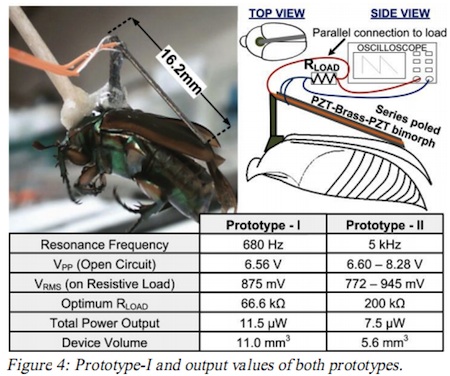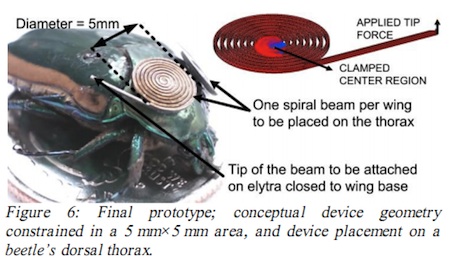Science Fiction
Dictionary
A B C D E F G H I J K L M N O P Q R S T U V W X Y Z
Harvesting Power From Flying Insects

The first successful mechanical energy scavenging from flying insects uses piezoelectric devices in little 'back-packs'.

(Power output from energy harvesting [pdf])
The device was created and described by scientists from the University of Michigan and Western Michigan University.
This paper reports the first effort to generate power from a live insect (Cotinis nitida - Green June Beetle) during its tethered flight, by utilizing piezoelectric devices in the d31 bending mode to convert mechanical vibrations of a beetle into electrical output. We measured available deflection, force and power output from oscillatory movements at different locations on a beetle with an unmounted piezoelectric beam and showed that up to ~115 micro Watts power generation is possible. Two initial generator prototypes were fabricated, mounted on a beetle, and harvested 11.5 micro Watts and 7.5 micro Watts in device volumes of 11.0 mm3 and 5.6 mm3 respectively, from 85 Hz-100 Hz wing strokes.

(Final prototype design for insect energy harvesting [pdf])
This work has real applications in the world of HI-MEMS (Hybrid Insect Micro-Electro-Mechanical Systems), which create cyborg beetles that can be remote-controlled. DARPA plans to use these insect/device hybrids as remote surveillance and sensing MAVs. The sensors and transponders need power, and harvesting power from the insect's flight is an ideal way to obtain energy, rather than using batteries.
DARPA HI-MEMS program director Amit Lal credits science fiction writer Thomas Easton with the idea for the HI-MEMS cyborg insect program, which recently reported success in embedding control devices in the pupal stage. Lal read Easton's 1990 novel Sparrowhawk, in which animals enlarged by genetic engineering were outfitted with implanted control systems.
Dr. Easton, a professor of science at Thomas College, sees a number of applications for HI-MEMS insects.
Moths are extraordinarily sensitive to sex attractants, so instead of giving bank robbers money treated with dye, they could use sex attractants instead. Then, a moth-based HI-MEMS could find the robber by following the scent.""[Also,] with genetic engineering DARPA could replace the sex attractant receptor on the moth antennae with receptors for other things, like explosives, drugs or toxins," said Easton.
Via Mechanical energy scavenging from flying insects (pdf).
Scroll down for more stories in the same category. (Story submitted 9/7/2011)
Follow this kind of news @Technovelgy.| Email | RSS | Blog It | Stumble | del.icio.us | Digg | Reddit |
Would
you like to contribute a story tip?
It's easy:
Get the URL of the story, and the related sf author, and add
it here.
Comment/Join discussion ( 0 )
Related News Stories - (" Engineering ")
Tornyol Microdrone Kills Mosquitoes
'The real border was defended by... a swarm of quasi-independent aerostats.'
PLATO Spacecraft, Hunter Of Habitable Planets, Now Ready
'I ... set my automatic astronomical instruments to searching for a habitable planet.' Edmond Hamilton (1936).
Did The Yautja Have These First?
What a marvel of ingenuity the little device was! - Harry Bates, 1934.
Jetson ONE Air Races Begin, Can Air Polo Be Far Behind?
'If you're one of those rarities who haven't attended a rocket-polo "carnage", let me tell you it's a colorful affair.' - John Victor Peterson, 1938.
Technovelgy (that's tech-novel-gee!) is devoted to the creative science inventions and ideas of sf authors. Look for the Invention Category that interests you, the Glossary, the Invention Timeline, or see what's New.
Science Fiction
Timeline
1600-1899
1900-1939
1940's 1950's
1960's 1970's
1980's 1990's
2000's 2010's
Current News
Proof Of Robothood - Not A Person
'Who are you people? - Show 'em.'
Dancing Robots Taught Dance Moves
'A clockwork figure would be the thing for you...'
Indonesian Clans Battle
'The observation vehicle was of that peculiar variety used in conveying a large number of people across rough terrain.'
The 'Last Mile' In China Crowded With Delivery Robots
Yes, it's a delivery robot. On wheels.
Tornyol Microdrone Kills Mosquitoes
'The real border was defended by... a swarm of quasi-independent aerostats.'
PLATO Spacecraft, Hunter Of Habitable Planets, Now Ready
'I ... set my automatic astronomical instruments to searching for a habitable planet.'
Factory Humanoid Robots Built By Humanoid Robots
'...haven't you a section of the factory where only robot labor is employed?'
iPhone Air Fulfils Jobs' Promise From 2007 - A Giant Screen!
'... oblongs were all over the floor and surfaces.'
ChatGPT Now Participates in Group Chats
'...the city was their laboratory in human psychology.'
iPhone Pocket All Sold Out!
'A long, strong, slender net...'
Did The Yautja Have These First?
What a marvel of ingenuity the little device was!
Jetson ONE Air Races Begin, Can Air Polo Be Far Behind?
'If you're one of those rarities who haven't attended a rocket-polo "carnage", let me tell you it's a colorful affair.'
Will Space Stations Have Large Interior Spaces Again?
'They filed clumsily into the battleroom, like children in a swimming pool for the first time, clinging to the handholds along the side.'
Mornine Sales Robot
'Robot-salesmen were everywhere, gesturing...'
Bipedal Robot Floats Gently While Walking
'a walking balloon proceeded with long strides of its aluminum legs...'
Musk Idea Of Cars Talking To Each Other Predicted 70 Years Ago
'My cars talk to one another.'
